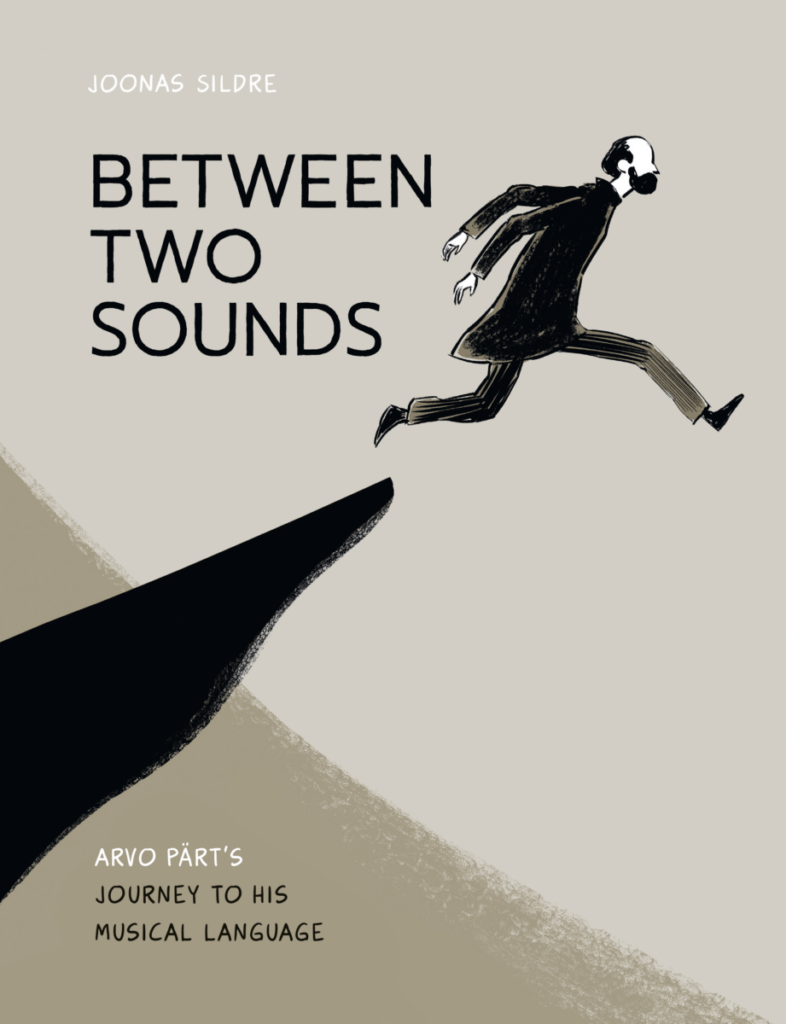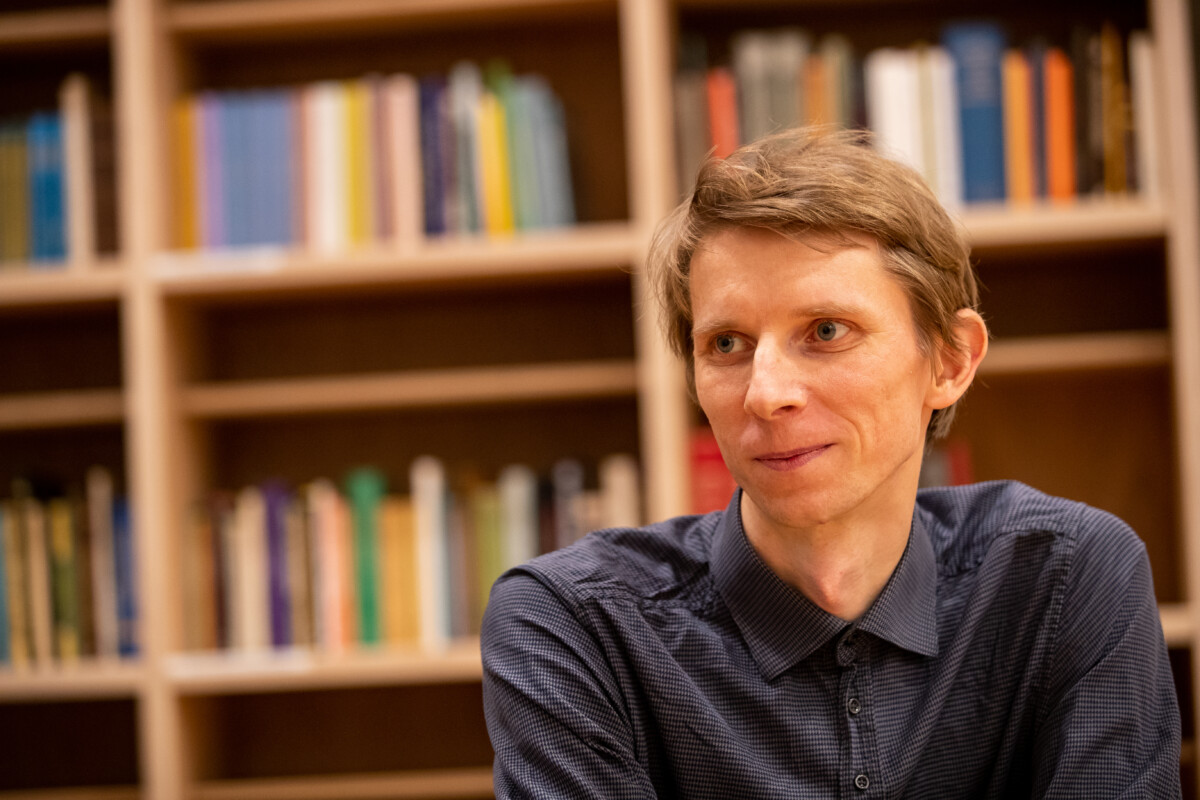Joonas Sildre’s graphic novel Between Two Sounds: Arvo Pärt’s Journey to His Musical Language was published in Estonian in the autumn of 2018. Sildre is one of very few Estonian artists whose primary tool has been, for nearly 20 years, the hybrid medium of comics – an art that combines pictures and words, thereby creating something greater than the sum of its parts.
Between Two Sounds was the first time that Sildre explicitly used the term graphic novel, which designates a freestanding comics work of 100 pages or more.[1] No doubt it was fitting to spotlight this label, given how slim Estonian comics culture has historically been. Still, whether or not the book should essentially be regarded as Estonia’s very first in the genre is a question of interpretation: it certainly surpasses earlier candidates in terms of volume (224 pp.), but at the same time, original comics have been published in that quantity in Estonia before, even as far back as the 1970s – no matter that they were primarily aimed towards children.
Sildre himself has also published children’s comic books before. The Pärt project, which sprung from genuine fascination and was in progress for more than a decade, in no way restricts its readership in terms of age, either. The concept of “comics about Arvo Pärt” (which the book basically represents) may sound amusing, and the outcome is humorous at times, but Sildre’s intention is not humor alone, and the book should not be prejudged as frivolous simply due to its format. Rather, Between Two Sounds is an impressively meticulous biographical study that boldly synthesizes multiple cultural spheres. It illustrates the development of Arvo Pärt’s personality and musical language, his perilous path in terms of both health and career, and his complex spiritual and creative quests up until the year 1980, when the Pärt family, dangerously disfavored by the Soviet regime, was finally forced to emigrate.
The biographical narrative’s source material, which is presented mainly in a classical linear style, was painstaking archival research and, once the project piqued the interest of its very inspiration, the personal recollections of Arvo and Nora Pärt themselves. Thus, Between Two Sounds is somewhat of an authorized autobiography and has aroused some doubts over whether the author perhaps allowed himself to be too limited by his subject’s interference. On the other hand, close consultation with the Pärt family helped to prevent numerous rumors, urban legends, and plain untruths about the composer from making it into print. Even in their absence, the book includes several striking episodes of Pärt’s often eccentric endeavors, though dozens of pages were ultimately weeded out of the fact-checked material and it cannot be deemed all-encompassing. For example, the period in which Pärt made a living by composing film soundtracks comes off as a somewhat embarrassing detail in the story, even though Ukuaru Waltz – perhaps his most well-known and beloved piece in Estonia – is of that very genre. It was, however, necessary to trim some facets so that the volume and tempo of the book would fit within reasonable bounds, and that the reader would not be distracted from the main axis of the story – a talented composer’s creative block and ultimate spiritual and musical rediscovery of himself, which leads him in turn into an unresolvable conflict with the Soviet regime.
In Estonia’s relatively sparse comics landscape, Between Two Sounds is a remarkable achievement even when considered as its simplest element – as a straightforward graphic biography – similar works about the lives of cultural greats are published by the dozen in Western Europe, but this is the first of its kind in Estonia. Yet what also makes the book stand out on the international literary scene is its artistic contribution: Sildre shapes the biographical content into a form that cleverly and creatively utilizes the opportunities the comics medium has to offer – one in which the (re)presentation of mundane scenes alternates smoothly with more abstract, intuitive segments.

The author’s practiced style of visual expression is nearly ascetic, excluding everything excess – even the color palette is crisp and barely extends beyond monochrome (and, it must be mentioned, this visual simplicity and focus purely on the essential is in discrete harmony with the music that served as the work’s inspiration). Great care is given to the accurate portrayal of historical and spatial details, buildings in Tallinn and other sites the protagonist visits, as well as the numerous secondary characters of greater or lesser celebrity in Estonian music, as is fitting for a biography. However, instead of limiting himself to the adequate composition of visual aesthetics, Sildre takes a giant step further: the cornerstone of the entire book is, in fact, its conceptual solution, through which he manages to conjure the world of sound and its emotional force in his drawings – an aspect, without which Pärt’s story would be almost unfathomable. The author devised a simple, genius answer to the question: how do you depict the undepictable, i.e. sounds? From the very beginning of the book, Arvo Pärt is accompanied by an abstract black dot akin to a single note, which visually symbolizes a limitless range of sounds as well as the human soul more broadly. Throughout various scenes, this dot can swell into a crescendo bombing a packed concert hall or shrink nearly out of existence, such as when representing the repressed sobs of an unknown guest in the stairwell on the eve of the Pärts’ exile. In moments of passion, spiritual self-discovery, and divine recognition, a flash of light may spark within the black dot. And it is in the book’s more abstract sections that depict Pärt’s inner monologue and his spiritual and creative quests – points at which the character detaches entirely from the real world – where Sildre’s virtuosity in his medium truly shines. Any attempt to recreate this same effect in a genre other than comics would seem impossible.
Between Two Sounds offers a simultaneously entertaining and enjoyably readable overview of the distinguished Estonian composer’s life (one that was absent in the literary format before), as well as an independent, deeply meditated, and unabashedly spiritual artistic experience of sometimes semi-epic proportions. Its release in the autumn of 2018 coincided with the opening of the Arvo Pärt Center in Laulasmaa, which also acted as the book’s publisher (since, to be honest, few established Estonian publishers would scramble to purchase the rights to an original graphic novel manuscript). As such, from a purely superficial perspective, one could find fault with the book’s business interests and the author’s scant critique of his subject – one wittier review rightly called it a “hagiographic novel”.[2] It is a fact that Sildre’s devoted, research-based approach to Pärt’s story is unvaryingly reverent. At the same time, he has achieved a sensorially genuine and engaging result that transcends the typical bounds and frameworks of Estonian culture. Dry numbers and the feedback given by readers – children and seniors alike – both confirm the book’s ability to connect to a broad audience; even one previously unfamiliar with the genre. Contrary to all expectations, the book became a bestseller and even surpassed popular new domestic novels in terms of sales. A second print run was released just a couple of months after the first, and a third has now been added in 2020. The Estonian media’s reception of Between Two Sounds was similarly unprecedented and wide-ranging for a graphic work, with the overwhelming majority of reviews being positive.
In the context of Estonian literary and comics history, Between Two Sounds will additionally be remembered for being the first work of its kind to be considered for national cultural awards: it was nominated for the Cultural Endowment of Estonia’s Award for Inter-Disciplinary Projects, and Sildre was a candidate for the 2018 Republic of Estonia’s Cultural Award for Creative Achievements. As a graphic novel, the work has so far only received moderate recognition outside of Estonia, simply because there are no comics awards issued in the country. Even as an unfinished project, Between Two Sounds was nominated for an award at the 2016 East London Comic Arts Festival. In the spring of 2020, it received special jury mention in the young-adult comics category of the BolognaRagazzi Award (part of the Bologna Children’s Book Fair), along with the commentary: “[T]he judges loved the sheer confidence here: the idea that an esoteric creative life (albeit one of a national hero in Estonia) could be turned into a comic book. And it has a more serious, underlying theme in the Estonians struggle under Soviet occupation. It is beautifully drawn. Astonishingly, the artist has found a way to convey creativity, and all the difficulties it involves.”[3]
The European comics market is, of course, much more extensive than Estonia’s, which means that competition is intense and Estonian cultural heroes have a difficult time becoming convincing sales items for francophone and anglophone publishers. That being said, Between Two Sounds is slated to be published soon in German and Lithuanian translations. A full, print-ready English translation by Adam Cullen has even been integrated into Sildre’s graphics – publishing rights are still available.
Mari Laaniste is an art academic whose focus is visual- and pop-culture, with a primary focus on studying Estonian animation and comics. She occasionally writes reviews and, even more infrequently, prose.
This work was supported by the Estonian Research Council grant PRG636.
[1] The work’s original title was Between Two Sounds: A Graphic Novel About Arvo Pärt.
[2] Ave Taavet, “Hagiograafliine roman Arvo Pärdist”. Vikerkaar, July 2019, https://www.vikerkaar.ee/archives/24598
[3] See http://www.bookfair.bolognafiere.it/en/highlights/awards/bolognaragazzi-award/bolognaragazzi-award-2020-winners/comics-young-adult-2020/10080.html (accessed 30 June 2020)

